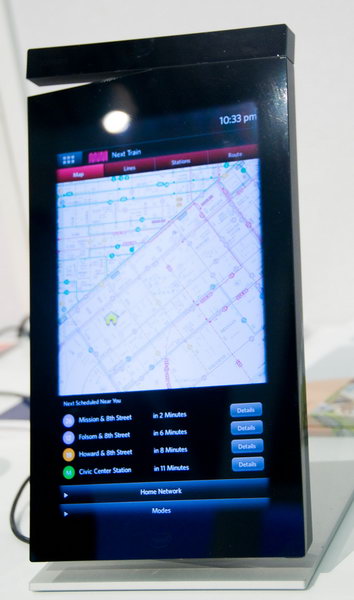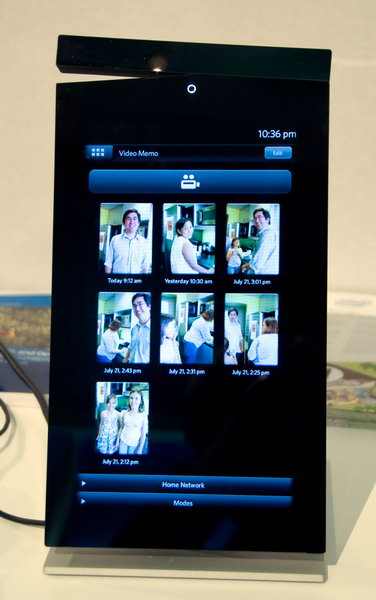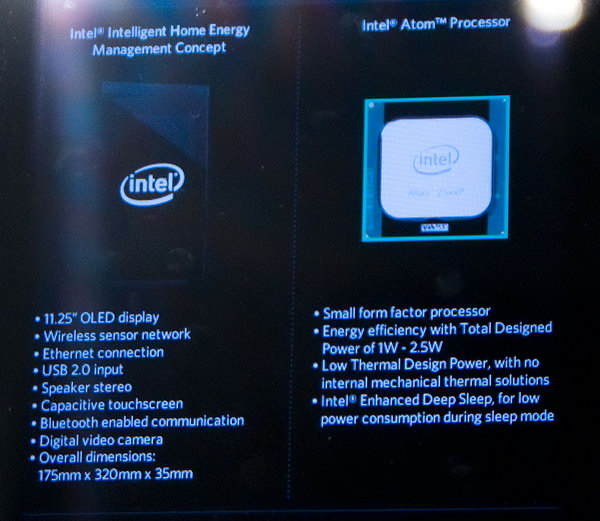Will smart homes of the future be built on the basis of Intel Atom?
The topic of so-called “smart houses” began to be actively discussed about ten years ago. By the standards of the IT industry is very, very much. At one time, it began to seem that soon the idea would go to the masses - it was no joke, even in Russia, they began to publish two monthly issues, where they signed the charms of housing intellectualization. Soon, however, everything was sub-verbal, the magazines closed, and the smart houses remained in science fiction films and novels? Why did it happen so? After all, it is difficult to find a person who would not want to settle in the home walls of a moderately intelligent system that helps to live and work. The reasons, in my opinion, are very simple.
As at the dawn of the computer industry, many very different systems have been released - incompatible with each other, of course. They, in turn, are equipped with their own interfaces, so a variety of sensors and expansion modules from one system will not fit into the other, even with the help of the Soldering Iron Warlock and the fairies of Tak-To-Mother. The price of developing systems and sensors is high, the market is small, and as a result, you have to take every buyer to its fullest, otherwise the costs will not be paid off.
Further more. Suppose that the most sophisticated system is installed in a house or apartment that controls everything, everything, and is currently the most perfect. But the house is not worth ten years, not twenty. And the filling in it is constantly changing. For example, you decided to change the audio system, and suddenly you find out that the new one does not want to be remotely controlled, not compatible with. Video surveillance decided to put color instead of black-and-white, oops - the same problem. Finally, the central module itself was jolted, dirty, darkened, and after five years it wanted to change it to a new one. Oops, for the company please change all the sensors and modules, well, or stay on the system of the same brand. With localization in general, the seams: to make qualitatively very expensive and troublesome, and from cheap wealthy clients will spit ...
')
In general, expensive turns fun. Very costly. And because really smart homes are extremely rare and increasingly in Japanese and English-speaking countries, and under their appearance is advertised remote control of the warm floor, switches that light up when receiving SMS and even acoustics for home theater with wireless rear speakers. Fun, fun, but to the smart home, as we know it from books and movies, no relationship.
However, the situation may soon change. It would seem, where does the Intel Atom? :)
Let's look at this photo together.

Personally, I immediately had associations with the weather station, which has long been at my home. Good thing - no need to look out the window to find out the temperature outside. And what with the weather predictions is lying regularly, so this is just AccuWeather more or less accurate.
But in the picture, The Intel Home Dashboard Concept is a prototype for the control center of a digital home in the near future. He was shown alive at the World Congress on IT, held last week in Amsterdam. By the way, in the presence of Intel head Paul Otellini.
The car is so smart that it is easier to say what it doesn’t know exactly how to walk a dog and pick up children from school. But to lay the best route for that and for the other is easy.

Another system constantly monitors the consumption of electricity, gas and water, while simultaneously tracking various changes at the supplier companies. For example, the action “Discount 15% from 23 to 6 o'clock” appeared, and Home Dashboard will immediately inform the owner about this by offering to connect to it with one click. Somewhere a pipe cracked and water consumption increased? Home Dashboard will also check this. Climate control work, air quality control, traffic information, babysitting and babysitting, baby shopping path tracking, sending and receiving email ...

There is also a client for Intel AppUp , from where the purchased applications will go to computers and smartphones registered in the home network.
The functionality of the system can be expanded almost infinitely, because it supports the entire standard set of modern wired and wireless interfaces. I emphasize - standard interfaces that are found in all computer and near-computer equipment. They will have enough speed for home needs for a very long time, and if they stop missing, you can replace Home Dashboard itself and some of the sensors, and let the others work for themselves thanks to backward compatibility, without which there is no PC anywhere.

With the help of a built-in camera, speakers and a microphone (more precisely, even several microphones - they can be additionally connected, as well as cameras), you can see and hear from anywhere in the world what is happening at home and, moreover, respond to what is happening. For example, turning on the siren and arranging illumination in all rooms, if someone decides to play the admin of the home server without asking.

And all this works on the Intel Atom Z530 processor, so even in conjunction with an 11.6-inch OLED touchscreen, the cost is quite low. But sensors and expansion modules, thanks to standard interfaces, can be done by almost everyone who wants it - as it is not necessary now to have the highest permission in order to do something with USB support. Yes, and the central unit in different variations can be assembled next to laptops and communicators - the components are all the same, by and large. As for the operating system, there is no information yet, but it looks like Moblin / MeeGo in appearance, and considering that there is quite a standard filling inside, the scope for experiments is huge.
The first Home Dashboard test implementations should begin in the fall, and if Taiwanese manufacturers like the results, you can expect quite real devices surrounded by a variety of different sensors and expansion modules. The latter can really be a great many: I was particularly pleased with the ability to automatically control the solar panels on the roof and track the level of humidity in the pots of domestic plants. Here I will buy a solar battery and flowers ...
It is clear that many functions (if not the majority) in Russia are not yet very realizable (I can see how Mosenergo comes up with discount programs and transmits information about them to the Internet). But for me, as a person constantly wandering around on business trips, such a quiet electronic attendant at home would be very useful. Especially if for the money.
And the last. Only one demonstration of the possibility of using the x86 architecture in “smart homes” is, of course, not enough for success. Well, if only few people recently believed in communicators on the Intel Atom, then home control systems are generally another opera, where the names of the soloists hardly say anything to computer scientists. At the same time, no one says that the mass market should be mastered only by the old guard. Who will do better and cheaper, that and sneakers.
And here, it seems, it turns out both better and cheaper at the same time.
As at the dawn of the computer industry, many very different systems have been released - incompatible with each other, of course. They, in turn, are equipped with their own interfaces, so a variety of sensors and expansion modules from one system will not fit into the other, even with the help of the Soldering Iron Warlock and the fairies of Tak-To-Mother. The price of developing systems and sensors is high, the market is small, and as a result, you have to take every buyer to its fullest, otherwise the costs will not be paid off.
Further more. Suppose that the most sophisticated system is installed in a house or apartment that controls everything, everything, and is currently the most perfect. But the house is not worth ten years, not twenty. And the filling in it is constantly changing. For example, you decided to change the audio system, and suddenly you find out that the new one does not want to be remotely controlled, not compatible with. Video surveillance decided to put color instead of black-and-white, oops - the same problem. Finally, the central module itself was jolted, dirty, darkened, and after five years it wanted to change it to a new one. Oops, for the company please change all the sensors and modules, well, or stay on the system of the same brand. With localization in general, the seams: to make qualitatively very expensive and troublesome, and from cheap wealthy clients will spit ...
')
In general, expensive turns fun. Very costly. And because really smart homes are extremely rare and increasingly in Japanese and English-speaking countries, and under their appearance is advertised remote control of the warm floor, switches that light up when receiving SMS and even acoustics for home theater with wireless rear speakers. Fun, fun, but to the smart home, as we know it from books and movies, no relationship.
However, the situation may soon change. It would seem, where does the Intel Atom? :)
Let's look at this photo together.

Personally, I immediately had associations with the weather station, which has long been at my home. Good thing - no need to look out the window to find out the temperature outside. And what with the weather predictions is lying regularly, so this is just AccuWeather more or less accurate.
But in the picture, The Intel Home Dashboard Concept is a prototype for the control center of a digital home in the near future. He was shown alive at the World Congress on IT, held last week in Amsterdam. By the way, in the presence of Intel head Paul Otellini.
The car is so smart that it is easier to say what it doesn’t know exactly how to walk a dog and pick up children from school. But to lay the best route for that and for the other is easy.

Another system constantly monitors the consumption of electricity, gas and water, while simultaneously tracking various changes at the supplier companies. For example, the action “Discount 15% from 23 to 6 o'clock” appeared, and Home Dashboard will immediately inform the owner about this by offering to connect to it with one click. Somewhere a pipe cracked and water consumption increased? Home Dashboard will also check this. Climate control work, air quality control, traffic information, babysitting and babysitting, baby shopping path tracking, sending and receiving email ...

There is also a client for Intel AppUp , from where the purchased applications will go to computers and smartphones registered in the home network.
The functionality of the system can be expanded almost infinitely, because it supports the entire standard set of modern wired and wireless interfaces. I emphasize - standard interfaces that are found in all computer and near-computer equipment. They will have enough speed for home needs for a very long time, and if they stop missing, you can replace Home Dashboard itself and some of the sensors, and let the others work for themselves thanks to backward compatibility, without which there is no PC anywhere.

With the help of a built-in camera, speakers and a microphone (more precisely, even several microphones - they can be additionally connected, as well as cameras), you can see and hear from anywhere in the world what is happening at home and, moreover, respond to what is happening. For example, turning on the siren and arranging illumination in all rooms, if someone decides to play the admin of the home server without asking.

And all this works on the Intel Atom Z530 processor, so even in conjunction with an 11.6-inch OLED touchscreen, the cost is quite low. But sensors and expansion modules, thanks to standard interfaces, can be done by almost everyone who wants it - as it is not necessary now to have the highest permission in order to do something with USB support. Yes, and the central unit in different variations can be assembled next to laptops and communicators - the components are all the same, by and large. As for the operating system, there is no information yet, but it looks like Moblin / MeeGo in appearance, and considering that there is quite a standard filling inside, the scope for experiments is huge.
The first Home Dashboard test implementations should begin in the fall, and if Taiwanese manufacturers like the results, you can expect quite real devices surrounded by a variety of different sensors and expansion modules. The latter can really be a great many: I was particularly pleased with the ability to automatically control the solar panels on the roof and track the level of humidity in the pots of domestic plants. Here I will buy a solar battery and flowers ...
It is clear that many functions (if not the majority) in Russia are not yet very realizable (I can see how Mosenergo comes up with discount programs and transmits information about them to the Internet). But for me, as a person constantly wandering around on business trips, such a quiet electronic attendant at home would be very useful. Especially if for the money.
And the last. Only one demonstration of the possibility of using the x86 architecture in “smart homes” is, of course, not enough for success. Well, if only few people recently believed in communicators on the Intel Atom, then home control systems are generally another opera, where the names of the soloists hardly say anything to computer scientists. At the same time, no one says that the mass market should be mastered only by the old guard. Who will do better and cheaper, that and sneakers.
And here, it seems, it turns out both better and cheaper at the same time.
Source: https://habr.com/ru/post/95070/
All Articles